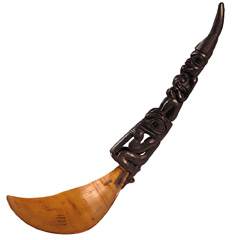One could call these ceremonial spoons the “family silver of Northwest Coast nobility,” says Bill Holm, curator emeritus at the Burke Museum of Indian Art in Seattle. “Our families’ histories are carved on these spoons,” says Tlingit clan leader David Katzeek.
Harvard’s Peabody Museum of Archaeology and Ethnology holds nearly 2,000 ethnographic objects—masks, totem poles, rattles, and regalia—made by tribes living between northern California and southeastern Alaska during the nineteenth century, among them 124 spoons. Some of these were purely utilitarian. Others, for use at feasts, have elaborately carved horn handles on which artists rendered figures from local oral histories just as they did on their much-better-known totem poles. For a noble or shaman to serve food or eat with one of these, in itself a potent spiritual act, was simultaneously to honor and nourish ancestral beings. Anthropologist Anne-Marie Victor-Howe, former Hrdy Fellow at the Peabody, now gives the spoons due attention in Feeding the Ancestors: Tlingit Carved Horn Spoons (Peabody Museum Press), and a selection of them is on exhibit at the museum through March of next year (see www.peabody.harvard.edu for details).
Victor-Howe was aided by Holm, Katzeek, and other Tlingit scholars in her interpretations of these carvings, which present a rich cast of animal and human, real and supernatural characters.
 |  |  |
| Tlingit Shaman Spoon | Tlingit Ceremonial Spoon | Tlingit Ceremonial Spoon |
| larger image & details | larger image & details | larger image & details |
The spoon at left has at the base of the handle an eye that represents a personified rock, island, or reef. A shaman wearing a headdress crowned with goat horns stands on it. He holds a land otter’s tail in his hands and mouth and appears to be eating a split otter. At the apex of the handle is a human-octopus being.
The figure at the base of the spoon handle at center is probably an eagle, although several of Victor-Howe’s consultants thought it could be a wolf. Above it sits a man wearing a clan-specific headdress with bear ears. His tongue reaches from his mouth to a land otter he holds in his arms.
A sea lion appears on the spoon at right, with a small bird forming the finial of the handle. In a native legend, a man known as Duktootl’, Blackskin, or Strong Man trained for years to improve his self-discipline and strength and then tore a large sea lion in half.
Hillel Burger 2004, Peabody Museum, President And Fellows Of Harvard College
Larger Images with Detailed Captions

The handle of a Tlingit shaman spoon depicting a shaman, a land otter, and an octopus. Circa 1840-1865. Mountain goat horn. 101/4 inches long overall. Collected by Edward G. Fast in 1867-1868, when he was a lieutenant in the U.S. Army stationed in Sitka, Alaska.

Tlingit ceremonial spoon with a carving of a man wearing a bear headdress. Circa 1840-1865. Mountain goat horn with a Dall sheep horn bowl. About 8 1/2 inches long. Also collected by Fast.

Tlingit ceremonial spoon showing a sea lion. Circa 1865-1900. Mountain goat horn. 6 inches long.





